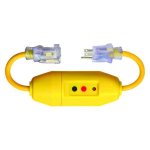Dave, Thank you!
A very important issue--and it is unusual, but extremely serious when the death occurs from electrical current transmitted thru the water.
The article seems to imply that this mostly occurs in fresh water, but it can occur in both salt and brackish water.
One of my objections is that the illustration and method of testing, relies on the power pedestal being the culprit. It is often the boat which is miss wired. So when checking for the proper wiring, the boat should be checked also.
Also there are some issues using a clamp on meter to measure the current where this may not show leaks, especially if it is an adjacent boat, or an adjacent boat with bad wiring. So be aware of not just your boat.
In my boat, I float the ground, and the only potential contact between the AC system is potentially the battery charger. So that should be looked at, as well. I put a ground fault interrupter in the extension cord (I only use 15 amp cords--where most of the C Dory built in 110 V systems use 30 amps.

This way you are protecting the boat before the power panel, instead of just a few plugs.
At my own docks, I put in a ground rod right by the dock power pole, since I have found as much as 2 volt differential due to a long run in the conduit or power un under the dock. (most docks do not have that luxury).
Probably the best advice is to
not swim in marinas!
Here is another
Boat US publication Which shows in more details the issues, and another way to test using a single copper plate as a test wand.
The device: Ideal Sure test Circuit Analyzer is about $350; But you can do all of that with a $45 Craftsman clamp on volt meter (which should be part of the electrical kit, and a $6 LED 15 amp circuit tester.
[/img]
 This way you are protecting the boat before the power panel, instead of just a few plugs.
This way you are protecting the boat before the power panel, instead of just a few plugs. 
